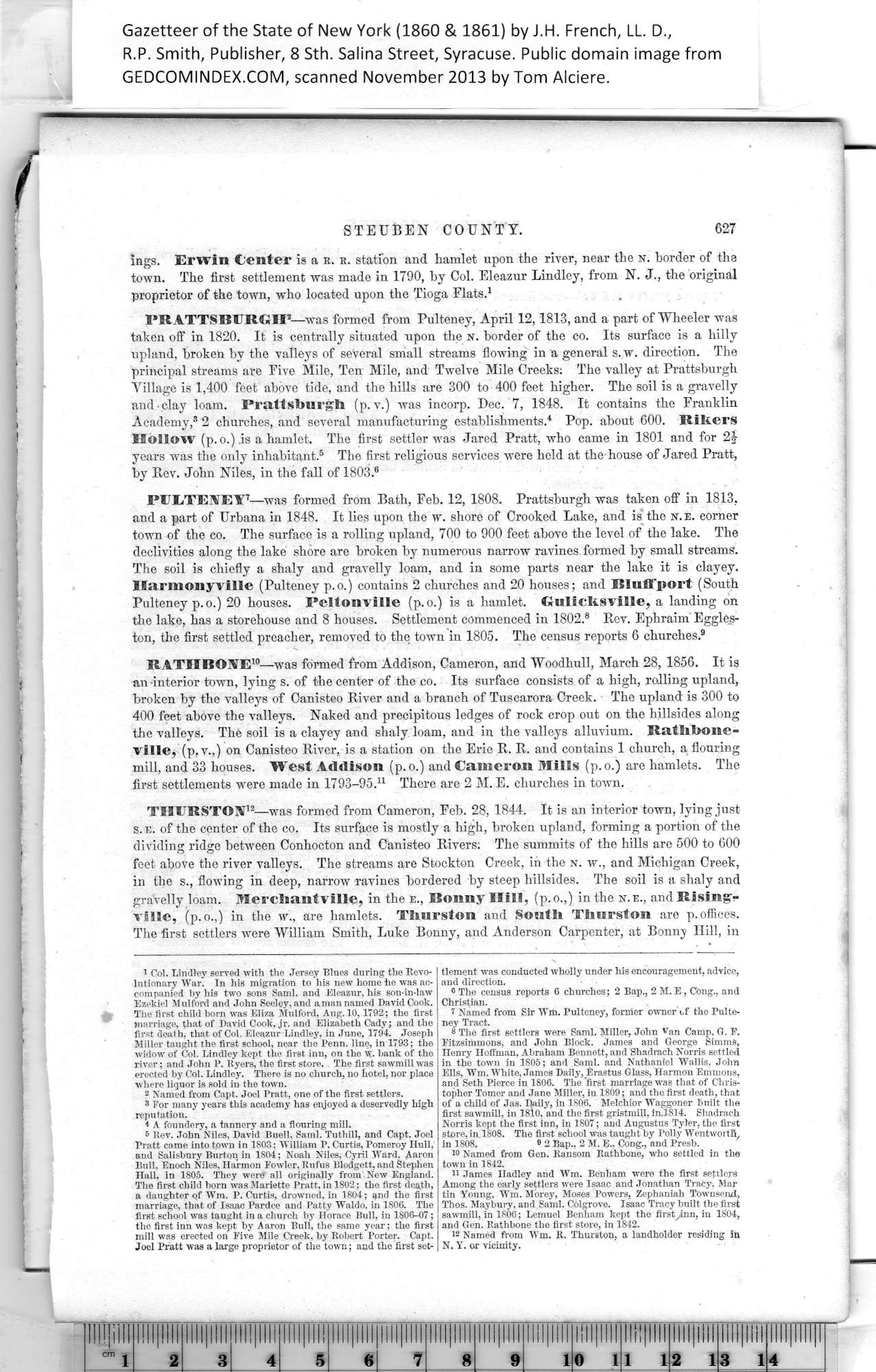|
STEUBEN COUNTY. 627
ings. Erwin Center is a r. r. station and hamlet upon the river, near the n. border of the
town. The first settlement was made in 1790, by Col. Eleazur Lindley, from N. J., the original
proprietor of the town, who located upon the Tioga Flats.1
PRATTSBURGH®—was formed from Pulteney, April 12,1813, and a part of Wheeler was
taken off in 1820. It is centrally situated upon the n. border of the co. Its surface is a hilly
upland, broken by the valleys of several small streams flowing in a general s. w. direction. The
principal streams are Five Mile, Ten Mile, and Twelve Mile Creeks; The valley at Prattsburgh
Tillage is 1,400 feet above tide, and the hills are 300 to 400 feet higher. The soil is a gravelly
and clay loam. PrattstourgH (p.v.) was incorp. Dec. 7, 1848. It contains the Franklin
Academy,® 2 churches, and several manufacturing establishments.4 Pop. about 600. Kilters
Hollow (p.o.) is a hamlet. The first settler was Jared Pratt, who came in 1801 and for 2J
years was the only inhabitant.5 The first religious services were held at the house of Jared Pratt,
by Rev. John Niles, in the fall of 1803.®
PITETENEY1—was formed from Bath, Feb. 12, 1808. Prattsburgh was taken off in 1813,
and a part of Urbana in 1848. It lies upon the w. shore of Crooked Lake, and is the n.e. corner
town of the co. The surface is a rolling upland, 700 to 900 feet above the level of the lake. The
declivities along the lake shore are broken by numerous narrow ravines formed by small streams.
The soil is chiefly a shaly and gravelly loam, and in some parts near the lake it is clayey.
Harmony ville (Pulteney p.o.) contains 2 churches and 20 houses; and BlufFport (South
Pulteney p.o.) 20 houses. Peltonville (p.o.) is a hamlet. GulicKsville, a landing on
the lake, has a storehouse and 8 houses. Settlement commenced in 1802.2 Rev. Ephraim Eggles¬
ton, the first settled preacher, removed to the town in 1805. The census reports 6 churches.3
RATH BONE4—was formed from Addison, Cameron, and Woodhull, March 28, 1856. It is
an interior town, lying s. of the center of the co. Its surface consists of a high, rolling upland,
broken by the valleys of Canisteo River and a branch of Tuscarora Creek. The upland is 300 to
400 feet above the valleys. Naked and precipitous ledges of rock crop out on the hillsides along
the valleys. The soil is a clayey and shaly loam, and in the valleys alluvium. Ratlibone-
vi!le, (p,v.,) on Canisteo River, is a station on the Erie R. R. and contains 1 church, a flouring
mill, and 33 houses. West Addison (p.o.) and Cameron Mills (p.o.) are hamlets. The
first settlements were made in 1793-95.5 There are 2 M. E. churches in town.
THfTRSTON6—was formed from Cameron, Feb. 28, 1844. It is an interior town, lying just
s. e. of the center of the co. Its surface is mostly a high, broken upland, forming a portion of the
dividing ridge between Conhocton and Canisteo Rivers; The summits of the hills are 500 to 600
feet above the river valleys. The streams are Stockton Creek, in the n. w., and Michigan Creek,
in the s., flowing in deep, narrow ravines bordered by steep hillsides. The soil is a shaly and
gravelly loam. Merctsantville, in the e., Bonny Hill, (p.o.,) in the n.e., and Rising-
ville, (p.o.,) in the w., are hamlets. Tlmrston and Sontli Tliurston are p.offices.
The first settlers were William Smith, Luke Bonny, and Anderson Carpenter, at Bonny Hill, in
|
tlement was conducted wholly under his encouragement, advice,
and direction.
6 The census reports 6 churches; 2 Bap., 2 M.E, Cong., and
Christian.
I Named from Sir Wm. Pulteney, former owner'of the Pulte¬
ney Tract.
8 The first settlers were Sami. Miller, John Van Camp, G. F.
Fitzsimmons, and John Block. James and George Simms,
Henry Hoffman, Abraham Bennett, and Shadrach Norris settled
in the town in 1805; and Sami, and Nathaniel Wallis, John
Ells, Wm. White, James Daily, Rrastus Glass, Harmon Emmons,
and Seth Pierce in 1806. The first marriage was that of Chris¬
topher Tomer and Jane Miller, in 1809; and the first death, that
of a child of Jas. Daily, in 1806. Melchior Waggoner built the
first sawmill, in 1810, and the first gristmill, in.1814. Shadrach
Norris kept the first inn, in 1807; and Augustus Tyler, the first-
store, in 1808. The first school was taught by Polly Wentworth
in 1808. 7 2 Bap., 2 M. B., Cong., and Presb.
10 Named from Gen. Ransom Rathbone, who settled in the
town in 1842.
II James Hadley and Wm. Benham were the first settlers
Among the early settlers were Isaac and Jonathan Tracy, Mar¬
tin Young, Wm. Morey, Moses Powers, Zephaniah Tovmsend,
Thos. Maybury, and Sami. Colgrove. Isaac Tracy built the first
sawmill, in 1806; Lemuel Benham kept the first^inn, in 1804,
and Gen. Rathbone the first store, in 1842.
12 Named from Wm. R. Thurston, a landholder residing in
N. Y. or vicinity. |
1
and Salisbury Burton in 1804; Noah Niles, Cyril Ward, Aaron
Bull, Enoch Niles, Harmon Fowler, Rufus Blodgett, and Stephen
2
Hall, in 1805. They were all originally from New England.
3
The first child horn was Mariette Pratt, in 1802 ; the first death,
4
a daughter of Wm. P. Curtis, drorvned, in 1804; and the first
marriage, that of Isaac Pardee and Patty Waldo, in 1806. The
5
first school was taught in a church by Horace Bull, in 1806-07;
6
the first inn was kept hy Aaron Bull, the same year; the first
mill was erected on Five Mile Creek, by Robert Porter. Capt.
Joel Pratt was a large proprietor of the town; and the first set¬
7
Pratt came into town in 1803; William P. Curtis, Pomeroy Hull,
|
